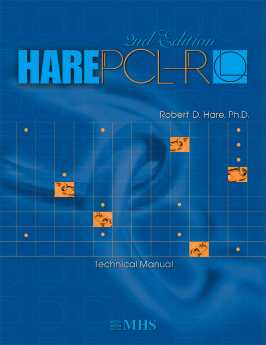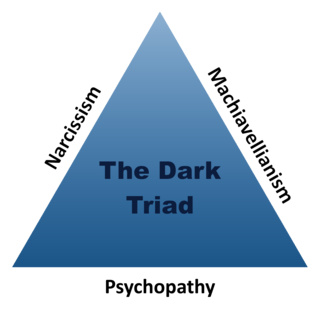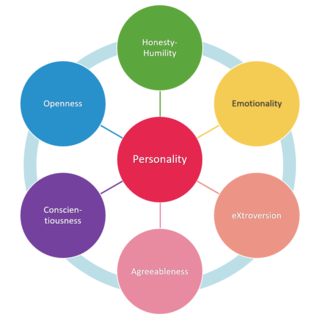Emotional intelligence (EI) is defined as the ability to perceive, use, understand, manage, and handle emotions. People with high emotional intelligence can recognize their own emotions and those of others, use emotional information to guide thinking and behavior, discern between different feelings and label them appropriately, and adjust emotions to adapt to environments.
Psychoticism is one of the three traits used by the psychologist Hans Eysenck in his P–E–N model model of personality.
Malignant narcissism is a psychological syndrome comprising an extreme mix of narcissism, antisocial behavior, aggression, and sadism. Grandiose, and always ready to raise hostility levels, the malignant narcissist undermines families and organizations in which they are involved, and dehumanizes the people with whom they associate.

Agreeableness is a personality trait referring to individuals that are perceived as kind, sympathetic, cooperative, warm, honest, and considerate. In personality psychology, agreeableness is one of the five major dimensions of personality structure, reflecting individual differences in cooperation and social harmony.
Psychopathy, or psychopathic personality is a personality construct characterized by impaired empathy and remorse, and bold, disinhibited, and egocentric traits masked by superficial charm and the outward presence of apparent normality.

The Psychopathy Checklist or Hare Psychopathy Checklist-Revised, now the Psychopathy Checklist—revised (PCL-R), is a psychological assessment tool that is commonly used to assess the presence and extent of the personality trait psychopathy in individuals—most often those institutionalized in the criminal justice system—and to differentiate those high in this trait from those with antisocial personality disorder, a related diagnosable disorder. It is a 20-item inventory of perceived personality traits and recorded behaviors, intended to be completed on the basis of a semi-structured interview along with a review of "collateral information" such as official records. The psychopath tends to display a constellation or combination of high narcissistic, borderline, and antisocial personality disorder traits, which includes superficial charm, charisma/attractiveness, sexual seductiveness and promiscuity, affective instability, suicidality, lack of empathy, feelings of emptiness, self-harm, and splitting. In addition, sadistic and paranoid traits are usually also present.

The dark triad is a psychological theory of personality, first published by Delroy L. Paulhus and Kevin M. Williams in 2002, that describes three notably offensive, but non-pathological personality types: Machiavellianism, sub-clinical narcissism, and sub-clinical psychopathy. Each of these personality types is called dark because each is considered to contain malevolent qualities.
In psychology, grandiosity is a sense of superiority, uniqueness, or invulnerability that is unrealistic and not based on personal capability. It may be expressed by exaggerated beliefs regarding one's abilities, the belief that few other people have anything in common with oneself, and that one can only be understood by a few, very special people. The personality trait of grandiosity is principally associated with narcissistic personality disorder (NPD), but also is a feature in the occurrence and expression of antisocial personality disorder, and the manic and hypomanic episodes of bipolar disorder.
The Narcissistic Personality Inventory (NPI) was developed in 1979 by Raskin and Hall, and since then, has become one of the most widely utilized personality measures for non-clinical levels of the trait narcissism. Since its initial development, the NPI has evolved from 220 items to the more commonly employed NPI-40 (1984) and NPI-16 (2006), as well as the novel NPI-1 inventory (2014). Derived from the DSM-III criteria for Narcissistic personality disorder (NPD), the NPI has been employed heavily by personality and social psychology researchers.
In psychology, manipulation is defined as subterfuge designed to influence or control another, usually in a underhanded manner which facilitates one's personal aims. Methods used to distort the individual's perception of reality may usually include seduction, suggestion, persuasion and blackmail to induce submission. Usage of the term varies in which behavior is specifically included, usually influenced by both culture and whether referring to the general population or used in clinical contexts. Manipulation is generally considered a dishonest form of social influence as it is used at the expense of others.
Sensation seeking is a personality trait defined by the search for experiences and feelings, that are "varied, novel, rich and intense", and by the readiness to "take physical, social, legal, and financial risks for the sake of such experiences." Risk is not an essential part of the trait, as many activities associated with it are not risky. However, risk may be ignored, tolerated, or minimized and may even be considered to add to the excitement of the activity. The concept was developed by Marvin Zuckerman of the University of Delaware. In order to assess this trait he created a personality test called the Sensation Seeking Scale. This test assesses individual differences in terms of sensory stimulation preferences. So there are people who prefer a strong stimulation and display a behavior that manifests a greater desire for sensations and there are those who prefer a low sensory stimulation. The scale is a questionnaire designed to measure how much stimulation a person requires and the extent to which they enjoy the excitement. Zuckerman hypothesized that people who are high sensation seekers require a lot of stimulation to reach their Optimal Level of Arousal. When the stimulation or sensory input is not met, the person finds the experience unpleasant.

The HEXACO model of personality structure is a six-dimensional model of human personality that was created by Ashton and Lee and explained in their book, The H Factor of Personality, based on findings from a series of lexical studies involving several European and Asian languages. The six factors, or dimensions, include honesty-humility (H), emotionality (E), extraversion (X), agreeableness (A), conscientiousness (C), and openness to experience (O). Each factor is composed of traits with characteristics indicating high and low levels of the factor. The HEXACO model was developed through similar methods as other trait taxonomies and builds on the work of Costa and McCrae and Goldberg. The model, therefore, shares several common elements with other trait models. However, the HEXACO model is unique mainly due to the addition of the honesty-humility dimension.
Persistence(PS) is a key personality trait identified by psychiatrist C. Robert Cloninger in his Psychobiological Model of Personality. It describes an individual's propensity to remain motivated, resilient and goal-driven in the face of challenges and difficulties they may encounter whilst carrying out tasks and working towards goals. More precisely, persistence refers to “perseverance in spite of fatigue or frustration”. According to Cloninger, this perseverance demonstrates a psychological determination that is foundational in aiding an individual's long-term success in achieving goals.
The Psychopathic Personality Inventory (PPI-Revised) is a personality test for traits associated with psychopathy in adults. The PPI was developed by Scott Lilienfeld and Brian Andrews to assess these traits in non-criminal populations, though it is still used in clinical populations as well. In contrast to other psychopathy measures, such as the Hare Psychopathy Checklist (PCL), the PPI is a self-report scale, rather than an interview-based assessment. It is intended to comprehensively index psychopathic personality traits without assuming particular links to anti-social or criminal behaviors. It also includes measures to detect impression management or careless responding.
The Levenson Self-Report Psychopathy scale (LSRP) is a 26-item, 4-point Likert scale, self-report inventory to measure primary and secondary psychopathy in non-institutionalized populations. It was developed in 1995 by Michael R. Levenson, Kent A. Kiehl and Cory M. Fitzpatrick. The scale was created for the purpose of conducting a psychological study examining antisocial disposition among a sample of 487 undergraduate students attending psychology classes at the University of California, Davis.
The honesty-humility factor is one of the six basic personality traits of the HEXACO model of personality. Honesty-humility is a basic personality trait representing the tendency to be fair and genuine when dealing with others, in the sense of cooperating with others, even when someone might utilize them without suffering retaliation. People with very high levels of the honesty-humility avoid manipulating for personal gain, feel little desire to break rules, are uninterested in wealth and luxuries, and feel no special right to elevated social status. Conversely, persons with very low levels on this scale will compliment others to get whatever they want, are inclined to break the rules for personal gains, are motivated by material gain, and feel a strong sense of self-importance.
The alternative five model of personality is based on the claim that the structure of human personality traits is best explained by five broad factors called impulsive sensation seeking (ImpSS), neuroticism–anxiety (N-Anx), aggression–hostility (Agg-Host), sociability (Sy), and activity (Act). The model was developed by Marvin Zuckerman and colleagues as a rival to the well-known five factor model of personality traits and is based on the assumption that "basic" personality traits are those with a strong biological-evolutionary basis. One of the salient differences between these two models is that the alternative five model lacks any equivalent to the dimension called openness to experience in the five factor model.
Delroy L. Paulhus is a personality psychology researcher and professor. He received his doctorate from Columbia University and has worked at the University of California, Berkeley and the University of California, Davis. Currently, Paulhus is a professor of psychology at the University of British Columbia in Vancouver, Canada where he teaches undergraduate and graduate courses. He is best known for being the co creator of the dark triad, along with fellow researcher Kevin Williams.
Machiavellianism in the workplace is a concept studied by many organizational psychologists. Conceptualized originally by Richard Christie and Florence Geis, Machiavellianism refers to a psychological trait concept where individuals behave in a cold and duplicitous manner. It has in recent times been adapted and applied to the context of the workplace and organizations by many writers and academics.

In the field of personality psychology, Machiavellianism is the name of a personality trait construct characterized by interpersonal manipulation, indifference to morality, lack of empathy, and a strategic focus on self-interest. Psychologists Richard Christie and Florence Geis named the construct after Niccolò Machiavelli, as they used edited statements inspired by his works to study variations in human behaviors. Their Mach IV test, a 20-question, Likert-scale personality survey, became the standard self-assessment tool and scale of the Machiavellianism construct. Those who score high on the scale are more likely to have a high level of manipulativeness, deceitfulness and a cynical, unemotional temperament.




